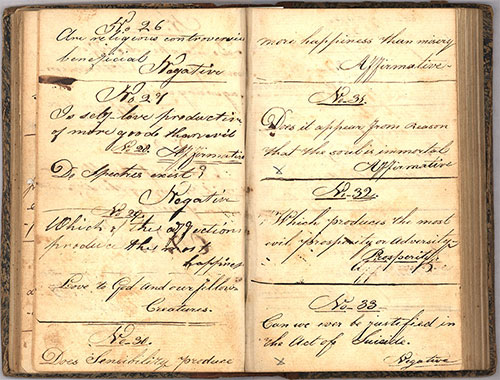
Minutes from the Young Ladies Literary Society founded in 1813 in Deerfield, Massachusetts. Image courtesy of Pocumtuck Valley Memorial Association Library.
The printer Isaiah Thomas noted that after the Revolution, “presses multiplied very fast, not only in seaports, but in all the principal inland towns and villages.” The resulting proliferation of books, periodicals, newspapers and pamphlets fueled what the historian David Jaffee has called the “Village Enlightenment.” Literary societies and social libraries founded in cities and towns throughout the new nation offered Americans access to crucial tools of self-education and cultural improvement.
For those who lived through it, the contrast between this new literary world and the experience of the previous generation could not have been greater. Ten years old at the outbreak of the American Revolution, Epaphras Hoyt of Deerfield recalled how, “In my early days, there was a great scarcity of Books. The family Bible, Watts Psalms and now and then a Sermon were found in families, but few ample libraries were to be seen here in our village.” Looking back a half century later in 1839, Hoyt marveled at the dizzying array of books and periodicals available compared to his youth: “Young men of the present day can hardly appreciate the advantages they possess, our forefathers, in the multiplication variety and cheapness of Books.” Printed resources abounded, “and if any complain of a want of opportunity to acquire useful knowledge, for all have their leisure hours, it must be from mental laxness in attitude rather than from a want of means.”
In the 18th century, people from families of modest means who wished to expand their intellectual horizons had depended on building their own or accessing the private libraries of more well-to-do members of the community. As a boy, Epaphras Hoyt capitalized on his family’s friendship with a local physician to gain access to “scientific Essays, History, voyages, travels, and Reviews of authors.” According to Hoyt, “if I have acquired any taste for reading, I attribute it almost wholly to the gratification I received from this fortunate circumstance.”
Instead of having to rely on the private collections and good will of wealthier book owners in their towns, the post-revolutionary generation banded together to found “social libraries.” Dues-paying members collectively purchased and shared books among themselves. Dr. James Deane of Greenfield, Massachusetts, a town just north of Deerfield, shared his own and gained access to other members’ books when he joined the "social library" in his town. These were the predecessors of “free libraries” established in towns later in the 19th century. Like the popular Lyceum lectures of the era, they reveal a wide-spread intellectual curiosity and thirst for self-improvement among ordinary men and women.
A social library founded in Deerfield in the early 1800s was typical of associations founded in this period for the purpose of acquiring and sharing books. Over a 30-year period, it built up a collection of almost 1,000 volumes. Categories of books and bound periodicals its members acquired and shared included biography, encyclopedias, history, poetry, literature, philosophy and science, political economy, law, natural history, theology and ethics, travels and voyages, novels, as well as other publications lumped together under “miscellaneous.”
Belonging to a social library was much less expensive than buying one’s own books, but it was not cheap. According to the bylaws of Deerfield’s Second Social Library, its members were required to pay annual dues of $4.00. Non-subscribers were permitted to borrow a book if they left a deposit and paid 12½ cents per week (a substantial sum at a time when laborers earned an average of 50 cents per day). Fines for unauthorized loans, overdue books, and damage (“For every drop of Tallow, 6 cents. Turning down a leaf, 6 cents”) helped preserve the books.
Just as important as the reading material the social libraries provided was the atmosphere of inquiry, discussion and debate they stimulated. Literary societies proliferated alongside social libraries in the early 19th century. In cities and towns throughout the country, citizens founded groups that met regularly to discuss the social and political issues of the day. In 1802, 28-year-old Silas Felton of Marlborough, Massachusetts, delivered an oration enthusiastically describing the way literary societies like Marlborough’s newly-formed Society of Social Enquirers forwarded the cause of republican liberty and progress. Felton declared that such societies encouraged perpetual improvement and learning among the people that was essential to sustaining free government. The founders of Deerfield’s Literary Adelphi, or “Literary Brotherhood,” similarly believed that engaged and educated citizens must take the lead in ushering in the new era of knowledge and freedom.
Literary societies were not confined to men. A number of young women joined the Young Ladies Literary Society, founded in Deerfield in 1813, including the young Preceptress (headmistress) of Deerfield Academy, Orra White. Members declared in the preamble to their society’s constitution that "Science and literature are the greatest promotives of human happiness." Subjects debated included, "What is the principal cause of evil in society?" ("Defective Education"); "Is the curiosity of the sexes equal?" (Affirmative.)”
Orra White, in company with other members of the Young Ladies Literary Society, Edward Hitchcock and the literary “brotherhood” of the Adelphi Society, and the subscribers of the social libraries represented a large and growing intellectual and social movement among an emerging American middle class. In concert with the array of religious and secular associations that defined social reform throughout the 19th century, the activities and ambitions of these “enlightened friends of humanity” would leave their own mark on the new nation’s civic landscape.